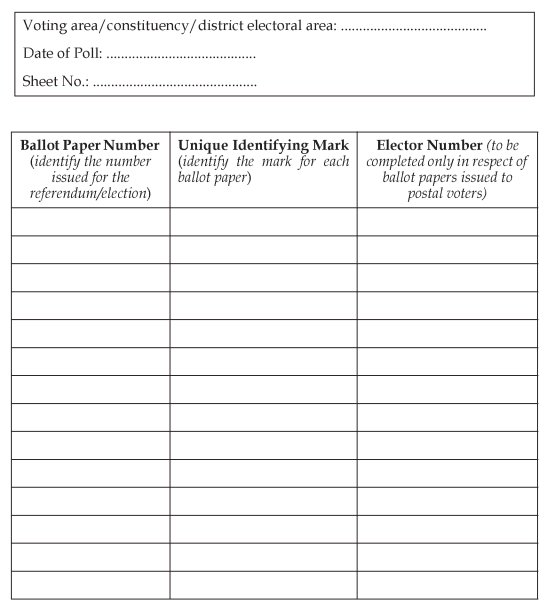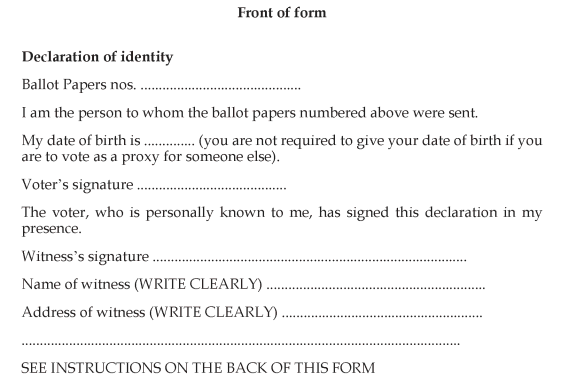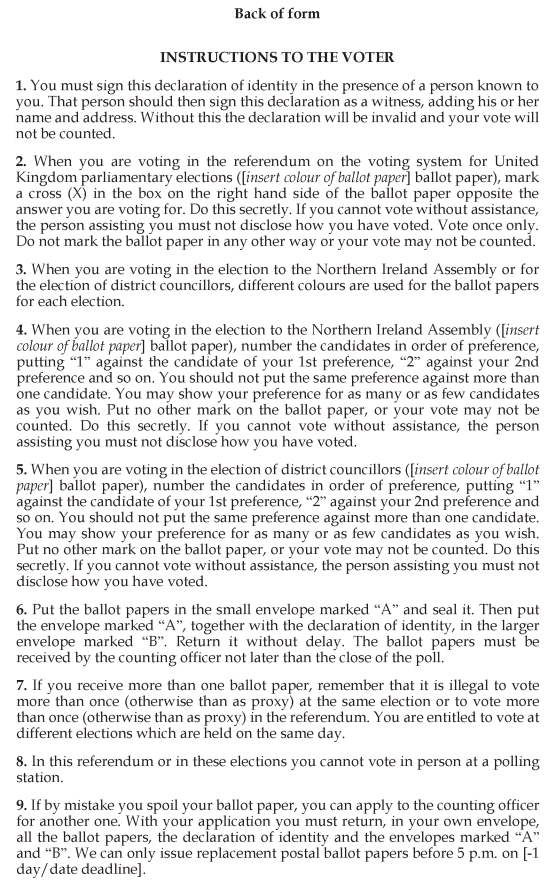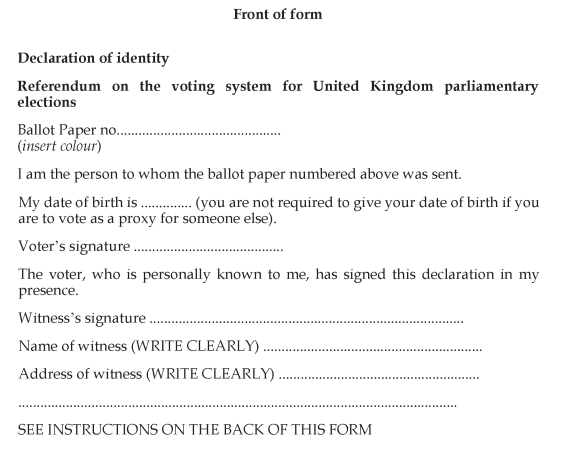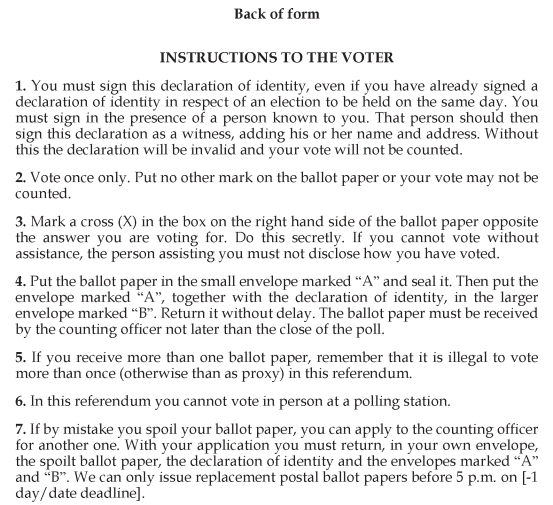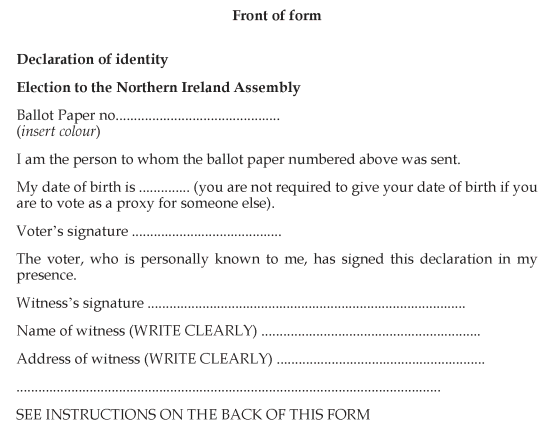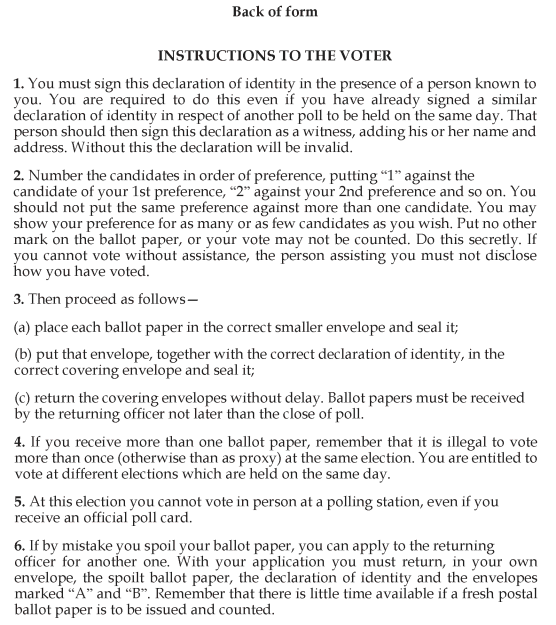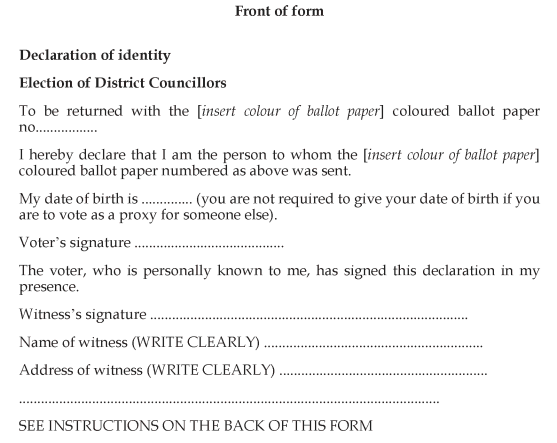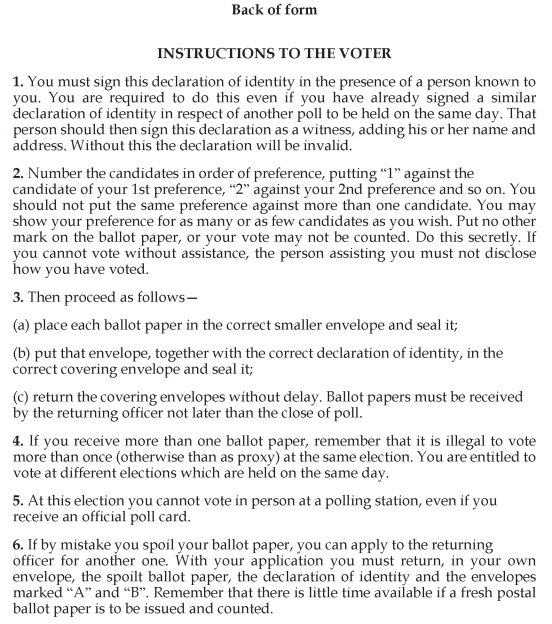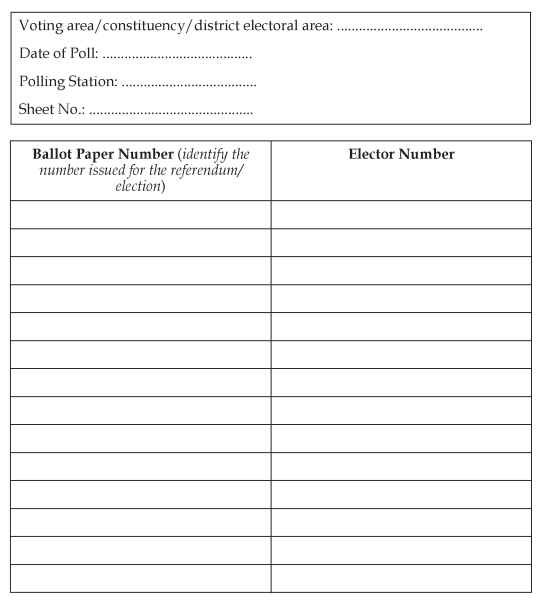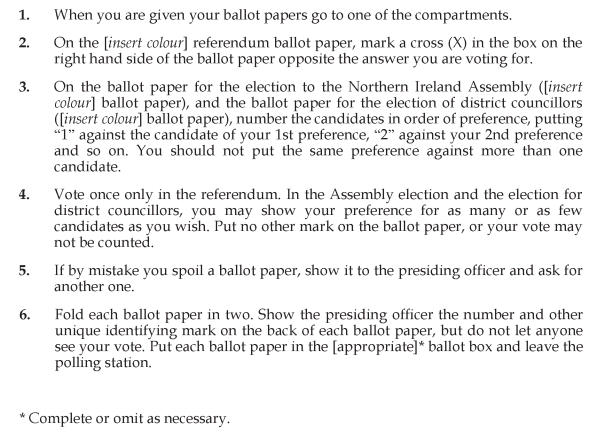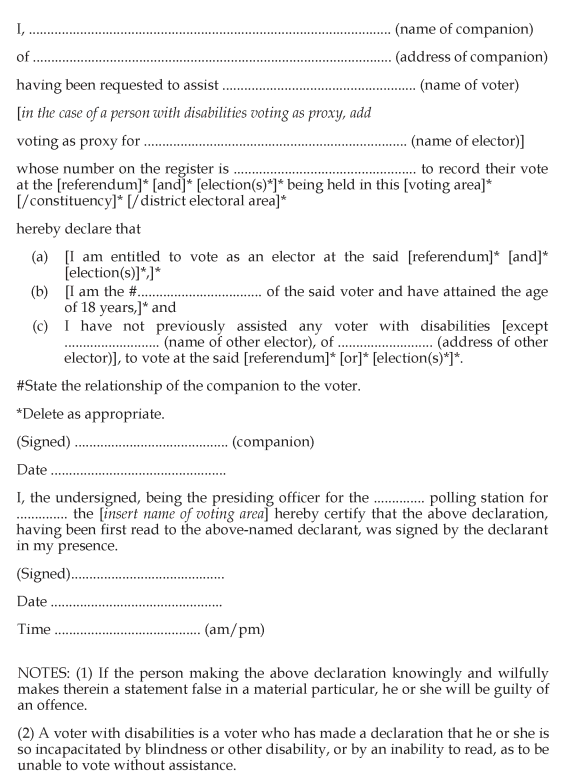SCHEDULES
Section 4
SCHEDULE 8Combination of polls: Northern Ireland
PART 1Provision about combination
General provisions
Interpretation
1(1)An election the poll for which is, under section 4(4), to be taken together with the poll for the referendum is referred to in this Schedule as a “relevant election”.
(2)The polls to be taken together are referred to in this Schedule as “combined polls”.
2In this Schedule—
“Assembly election” means an election to the Northern Ireland Assembly;
“Assembly Elections Rules” means the parliamentary elections rules as applied for the purposes of Assembly elections by Article 3(1) of, and Schedule 1 to, the Northern Ireland Assembly (Elections) Order 2001 (S.I. 2001/2599);
“Chief Electoral Officer” means the Chief Electoral Officer for Northern Ireland;
“counting agent” means a counting agent for the referendum or a counting agent for a relevant election (except where one or other is specified);
“local election” has the meaning given in section 130(1) of the Electoral Law Act (Northern Ireland) 1962;
“Local Elections Rules” means the rules set out in Schedule 5 to the Electoral Law Act (Northern Ireland) 1962.
Cost of combined polls
3The cost of taking the combined polls (excluding any cost solely attributable to the referendum or to a particular relevant election), and any cost attributable to their combination, is to be apportioned equally among them.
Publication of statement of persons nominated
4(1)The statement of persons nominated at the relevant elections must be published by not later than the 15th day before the date of the poll.
(2)The timetables set out in the following provisions are to be read with whatever modifications are necessary to give effect to sub-paragraph (1)—
(a)rule 1 of the Assembly Elections Rules;
(b)rule 1 of the Local Elections Rules.
Directions by Chief Counting Officer to Chief Electoral Officer
5(1)The reference in paragraph 5(5)(a) of Schedule 1 to a counting officer’s functions includes (subject to sub-paragraph (5)) the functions of the Chief Electoral Officer that are conferred by—
(a)the relevant provisions of the Assembly Elections Rules;
(b)the relevant provisions of the Local Elections Rules;
(c)Part 5 of the Representation of the People (Northern Ireland) Regulations 2008 (S.I. 2008/1741) or Part 3 of Schedule 2 to the Local Elections (Northern Ireland) Order 1985 (S.I. 1985/454) (issue and receipt of postal ballot papers);
(d)paragraph 33(1), (2)(b) and (6) below.
(2)The reference in paragraph 5(5)(c) of that Schedule to information that a counting officer has or is entitled to have includes information that the Chief Electoral Officer has, or is entitled to have, by virtue of exercising those functions.
(3)The relevant provisions of the Assembly Elections Rules are—
(a)rule 19A (corresponding number list);
(b)rule 23(2) (notice of situation of polling stations etc);
(c)rule 24 (postal ballot papers);
(d)rule 25 (provision of polling stations);
(e)in rule 26 (appointment of presiding officers and clerks), paragraph (1) to the extent that it concerns the appointment of presiding officers and clerks to assist them, and paragraph (2);
(f)rule 29 (equipment of polling stations);
(g)rule 31(a) (notification of requirement of secrecy at polling stations);
(h)rule 31A (return of postal ballot papers);
(i)rule 32(3) (certificate as to employment);
(j)rule 33(2)(b) (authorisation to remove person from polling station).
(4)The relevant provisions of the Local Elections Rules are—
(a)rule 16A (corresponding number list);
(b)rule 20(2) (notice of situation of polling stations etc);
(c)rule 21 (postal ballot papers);
(d)rule 22 (provision of polling stations);
(e)in rule 23 (appointment of presiding officers and clerks), paragraph (1) to the extent that it concerns the appointment of presiding officers and clerks to assist them, and paragraph (2);
(f)rule 26 (equipment of polling stations);
(g)rule 28(a) (notification of requirement of secrecy at polling stations);
(h)rule 29(3) (certificate as to employment);
(i)rule 30(2)(b) (authorisation to remove person from polling station).
(5)Functions of the Chief Electoral Officer conferred by—
(a)a provision referred to in sub-paragraph (1)(c), (3)(c) or (h) or (4)(c),
(b)rule 19A of the Assembly Elections Rules to the extent that it relates to ballot papers issued in pursuance of rule 24(1) of those rules,
(c)rule 16A of the Local Elections Rules to the extent that it relates to ballot papers issued in pursuance of rule 21(1) of those rules, or
(d)paragraph 33(2)(b) below,
fall within sub-paragraph (1) only where the Chief Electoral Officer decides that the proceedings on the issue and receipt of postal ballot papers in respect of the referendum and the relevant elections are to be taken together.
(6)The Chief Electoral Officer may not decide that the proceedings on the issue and receipt of postal ballot papers in respect of the referendum and the relevant elections are to be taken together unless the Chief Counting Officer agrees.
Forms
6Forms 2 to 5, 7 and 8 in Part 3 of this Schedule are “relevant forms” for the purposes of rule 10 of the referendum rules.
Action to be taken before poll
Corresponding number lists
7(1)This paragraph applies where the Chief Electoral Officer decides that the proceedings on the issue and receipt of postal ballot papers in respect of the referendum and the relevant elections are to be taken together.
(2)If the Chief Electoral Officer thinks fit, the lists to be prepared under the following provisions may be combined in the form set out in Form 1 in Part 3 of this Schedule—
(a)rule 6 of the referendum rules;
(b)rule 19A of the Assembly Elections Rules;
(c)rule 16A of the Local Elections Rules.
(3)In that case, this paragraph applies instead of—
(a)rule 6(2) of the referendum rules;
(b)rule 19A(2) of the Assembly Elections Rules;
(c)rule 16A(2) of the Local Elections Rules.
8(1)This paragraph applies where the Chief Electoral Officer decides that the proceedings on the issue and receipt of postal ballot papers in respect of the referendum and the relevant elections are not to be taken together.
(2)If the Chief Electoral Officer thinks fit, the officer may prepare a single list containing the numbers and other unique identifying marks of all of the ballot papers to be provided to presiding officers in pursuance of the following provisions—
(a)rule 17(1) of the referendum rules;
(b)rule 29(1) of the Assembly Elections Rules;
(c)rule 26(1) of the Local Elections Rules.
(3)The list must be in the form set out in Form 1 in Part 3 of this Schedule.
(4)If a list is prepared in relation to ballot papers under this paragraph, the list prepared under the following provisions must not include details relating to those ballot papers—
(a)rule 6 of the referendum rules;
(b)rule 19A of the Assembly Elections Rules;
(c)rule 16A of the Local Elections Rules.
(5)A reference in an enactment to a list prepared under a provision mentioned in sub-paragraph (4) has effect, in so far as it relates to ballot papers to be provided in pursuance of the provisions mentioned in sub-paragraph (2), as a reference to the list prepared under this paragraph.
Notice of polling stations
9(1)The notice given under rule 11(3) of the referendum rules must—
(a)state that the poll for the referendum is to be taken together with the poll for the relevant elections, and
(b)specify the constituency or district council for which each relevant election is to be held.
(2)The notice given under rule 23(2) of the Assembly Elections Rules must—
(a)state that the poll for the Assembly election is to be taken together with the poll for the referendum, and
(b)state that the poll for the Assembly election is to be taken together with the poll for a local election, specifying the relevant district council.
(3)The notice given under rule 20(2) of the Local Elections Rules must—
(a)state that the poll for the local election is to be taken together with the poll for the referendum, and
(b)state that the poll for the local election is to be taken together with the poll for an Assembly election, specifying the relevant constituency.
Declarations of identity
10(1)This paragraph applies where the Chief Electoral Officer decides that the proceedings on the issue and receipt of postal ballot papers in respect of the referendum and the relevant elections are to be taken together.
(2)The declaration of identity to be issued to those entitled to vote by post in the referendum and in the relevant elections must be in the form set out in Form 2 in Part 3 of this Schedule.
(3)Where that form is used, this paragraph applies instead of any requirement in the following provisions for a declaration of identity to be in a particular form.
(4)The provisions are—
(a)rule 12(1)(c) of the referendum rules;
(b)rule 24(1)(c) of the Assembly Elections Rules;
(c)rule 21(1) of the Local Elections Rules.
11(1)This paragraph applies where the Chief Electoral Officer decides that the proceedings on the issue and receipt of postal ballot papers in respect of the referendum and the relevant elections are not to be taken together.
(2)The declaration of identity to be issued to those entitled to vote by post in the referendum must be in the form set out in Form 3 in Part 3 of this Schedule.
(3)Sub-paragraph (2) applies instead of the requirement in rule 12(1)(c) of the referendum rules for a declaration of identity to be in a particular form.
(4)The declaration of identity to be used by those entitled to vote by post in the Assembly election must be in the form set out in Form 4 in Part 3 of this Schedule.
(5)Sub-paragraph (4) applies instead of the requirement in rule 24(1) of the Assembly Elections Rules for a declaration of identity to be in a particular form.
(6)The declaration of identity to be used by those entitled to vote by post in the local election must be in the form set out in Form 5 in Part 3 of this Schedule.
(7)Sub-paragraph (6) applies instead of the requirement in rule 21(1) of the Local Elections Rules for a declaration of identity to be in a particular form.
Colour of ballot papers
12The ballot papers used for the referendum and for each relevant election must be of a different colour.
Polling stations
13The referendum polling stations are to be used for the combined polls.
Official poll cards
14(1)If the Chief Electoral Officer thinks fit, the official poll cards used for the referendum and the relevant elections may be combined.
(2)In that case, the forms required to be used for official poll cards for the referendum and relevant elections must be adapted in whatever manner seems necessary.
Ballot boxes
15(1)If the Chief Electoral Officer thinks fit, the same ballot box may be used at the polls for the referendum and the relevant elections.
(2)Where separate ballot boxes are used, each must be clearly marked to show—
(a)the poll to which it relates, and
(b)the colour of ballot papers that should be placed in it.
Form of corresponding number lists provided to polling stations
16(1)If the Chief Electoral Officer thinks fit, the lists to be provided under the following provisions may be combined in the form set out in Form 6 in Part 3 of this Schedule—
(a)rule 17(3)(d) of the referendum rules;
(b)rule 29(3)(e) of the Assembly Elections Rules;
(c)rule 26(3)(e) of the Local Elections Rules.
(2)In that case, this paragraph applies instead of—
(a)the second sentence in rule 17(3) of the referendum rules;
(b)rule 26(3ZC) of the Local Elections Rules.
Ballot paper displayed in polling stations
17(1)The large version of the ballot paper displayed inside the polling station under rule 17(4)(a) of the referendum rules must be of the same colour as the ballot papers to be used for the referendum.
(2)The large version of the ballot paper displayed inside the polling station under rule 29(3A)(a) of the Assembly Elections Rules must be of the same colour as the ballot papers to be used for the Assembly election.
(3)The large version of the ballot paper displayed inside the polling station under rule 26(3A)(a) of the Local Elections Rules must be of the same colour as the ballot papers to be used for the local election.
Guidance to be exhibited outside and inside polling stations
18(1)Rule 17 of the referendum rules has effect as if—
(a)in paragraph (6), for “inside and outside every polling station” there were substituted “outside every polling station and in every compartment of every polling station”, and
(b)paragraph (7) were omitted.
(2)Rule 29 of the Assembly Elections Rules has effect as if—
(a)in paragraph (4), for “inside and outside every polling station” there were substituted “outside every polling station and in every compartment of every polling station”, and
(b)paragraph (5) were omitted.
(3)The notice referred to in rule 29(4) of the Assembly Elections Rules or rule 26(4) of the Local Elections Rules—
(a)must clearly indicate the election to which it relates, and
(b)must be on paper of the same colour as the ballot papers used for the election to which it relates,
and the notice referred to in rule 17(6) of the referendum rules must be on paper of the same colour as the ballot papers used for the referendum.
(4)If the Chief Electoral Officer thinks fit, a notice in the form set out in Form 7 in Part 3 of this Schedule, giving directions for the guidance of voters in voting—
(a)must be printed in conspicuous characters;
(b)must be exhibited outside every polling station and in every compartment of every polling station.
(5)In that case, paragraph (4) applies instead of—
(a)paragraphs (1) to (3);
(b)rule 17(6) and (7) of the referendum rules;
(c)rule 29(4) and (5) of the Assembly Elections Rules;
(d)rule 26(4) of the Local Elections Rules.
The poll
Admission to the polling station
19(1)Rule 21(1) of the referendum rules has effect as if the persons listed there included persons who would be entitled to be admitted to the polling station for any relevant election if the poll for that election were held on its own.
(2)Rule 32(1) of the Assembly Elections Rules has effect as if the persons listed there included—
(a)persons who would be entitled to be admitted to the polling station for the referendum if the poll for the referendum were held on its own, and
(b)persons who would be entitled to be admitted to the polling station for the local election if the poll for that election were held on its own.
(3)Rule 29(1) of the Local Elections Rules has effect as if the persons listed there included—
(a)persons who would be entitled to be admitted to the polling station for the referendum if the poll for the referendum were held on its own, and
(b)persons who would be entitled to be admitted to the polling station for the Assembly election if the poll for that election were held on its own.
Questions to be put to voters
20(1)Rule 35 of the Assembly Elections Rules has effect as if, in the questions in entries 1, 2 and 4 of the table in paragraph (1), after “at this” (in each place) there were inserted “Assembly”.
(2)Rule 32 of the Local Elections Rules has effect as if, in paragraphs (1) and (2), after “at this” (in each place) there were inserted “local”.
Voting procedure: copies of registers and lists of proxies
21(1)If the Chief Electoral Officer thinks fit, the same copy of the register of electors may be used under the following provisions for the purposes of the referendum and the relevant elections—
(a)rule 28(2) of the referendum rules;
(b)rule 37(1) of the Assembly Elections Rules;
(c)rule 34(1) of the Local Elections Rules.
(2)Sub-paragraphs (3) and (4) apply where the same copy of the register is used as mentioned in sub-paragraph (1).
(3)In a case where a ballot paper is delivered at the same time in respect of the referendum and the relevant elections, a single mark must be placed in the register against the number of the elector under—
(a)rule 28(2)(c) of the referendum rules,
(b)rule 37(1)(d) of the Assembly Elections Rules, and
(c)rule 34(1)(d) of the Local Elections Rules.
(4)In any other case, a mark must be placed in the register against the number of the elector identifying the poll to which each ballot paper delivered relates.
(5)In the case of an elector who is added to the register in pursuance of a notice issued under section 13BA(9) of the 1983 Act—
(a)references in this paragraph to the copy of the register of electors are to be read as references to the copy of the notice;
(b)references to a mark being placed in the register of electors are to be read as references to a mark being made on the copy of the notice.
22(1)If the Chief Electoral Officer thinks fit, he or she may require the relevant registration officer to produce a combined list of proxies for the referendum and the relevant elections.
(2)The following provisions apply where the lists are combined and a person applies for a ballot paper as proxy.
(3)Immediately before delivery of the ballot paper the list of proxies must be marked in a way that identifies—
(a)the proxy,
(b)the elector for whom the proxy is applying for the ballot paper, and
(c)the referendum or relevant election to which the ballot paper relates.
(4)Sub-paragraph (3) applies instead of—
(a)rule 28(2)(d) of the referendum rules;
(b)rule 37(1)(e) of the Assembly Elections Rules;
(c)rule 34(1)(e) of the Local Elections Rules.
23(1)This paragraph applies where the Chief Electoral Officer decides that the proceedings on the issue and receipt of postal ballot papers in respect of the referendum and the relevant elections are to be taken together.
(2)If the Chief Electoral Officer thinks fit, he or she may require the relevant registration officer to produce—
(a)a combined postal voters list, consisting of the things that would otherwise be included in—
(i)the postal voters list for the referendum;
(ii)the list under paragraph 2(4)(a) of Part 1 of Schedule 2 to the Local Elections Order;
(iii)the list under section 7(4)(a) of the Representation of the People Act 1985 as applied for the purposes of Assembly elections by Article 3(1) of, and Schedule 1 to, the Northern Ireland Assembly (Elections) Order 2001;
(b)a combined proxy postal voters list, consisting of the things that would otherwise be included in—
(i)the proxy postal voters list for the referendum;
(ii)the list under paragraph 4(8) of Part 1 of Schedule 2 to the Local Elections Order;
(iii)the list under section 9(9) of the Representation of the People Act 1985 as applied for the purposes of Assembly elections by Article 3(1) of, and Schedule 1 to, the Northern Ireland Assembly (Elections) Order 2001.
(3)Where appropriate—
(a)a reference in any enactment to a list mentioned in sub-paragraphs (i) to (iii) of sub-paragraph (2)(a) is to be read as a reference to the combined postal voters list;
(b)a reference in any enactment to a list mentioned in sub-paragraphs (i) to (iii) of sub-paragraph (2)(b) is to be read as a reference to the combined proxy postal voters list.
List of votes marked by presiding officer
24(1)If the Chief Electoral Officer thinks fit, a single list of votes marked by the presiding officer may be used for the purposes of the referendum and the relevant elections.
(2)Where a person’s entry in that list does not relate to the referendum and each relevant election the entry must—
(a)indicate whether it relates to the referendum, and
(b)identify any relevant election to which it relates.
(3)In this paragraph “list of votes marked by the presiding officer” means a list compiled under—
(a)rule 30(4) of the referendum rules,
(b)rule 38(2) of the Assembly Elections rules, or
(c)rule 35(3) of the Local Elections Rules.
Declaration to be made by the companion of a voter with disabilities
25(1)A declaration made by the companion of a voter with disabilities must be in the form set out in Form 8 in Part 3 of this Schedule.
(2)In this paragraph “declaration made by the companion of a voter with disabilities” means a declaration made by a companion under—
(a)rule 31 of the referendum rules,
(b)rule 39 of the Assembly Elections Rules, or
(c)rule 36 of the Local Elections Rules.
(3)This paragraph applies instead of—
(a)rule 31(5)(a) of the referendum rules;
(b)rule 39(5)(a) of the Assembly Elections Rules;
(c)rule 36(5)(a) of the Local Rules.
List of voters with disabilities assisted by companions
26(1)If the Chief Electoral Officer thinks fit, a single list of voters with disabilities assisted by companions may be used for the purposes of the referendum and the relevant elections.
(2)Where a person’s entry in that list does not relate to the referendum and each relevant election the entry must—
(a)indicate whether it relates to the referendum, and
(b)identify any relevant election to which it relates.
(3)In this paragraph “list of voters with disabilities assisted by companions” means a list compiled under—
(a)rule 31(8) of the referendum rules,
(b)rule 39(4) of the Assembly Elections Rules, or
(c)rule 36(4) of the Local Elections Rules.
Tendered votes list
27(1)If the Chief Electoral Officer thinks fit, a single tendered votes list may be used for the purposes of the referendum and the relevant elections.
(2)Where a person’s entry in that list does not relate to the referendum and each relevant election the entry must—
(a)indicate whether it relates to the referendum, and
(b)identify any relevant election to which it relates.
(3)In this paragraph “tendered votes list” means a list compiled under—
(a)rule 33(7) of the referendum rules,
(b)rule 40(3) of the Assembly Elections Rules, or
(c)rule 37(6) of the Local Elections Rules.
Lists relating to correction of errors on day of poll
28(1)If the Chief Electoral Officer thinks fit, a single list of persons to whom ballot papers are delivered in consequence of late alterations to the register may be used for the purposes of the referendum and the relevant elections.
(2)Where a person’s entry in that list does not relate to the referendum and each relevant election the entry must—
(a)indicate whether it relates to the referendum, and
(b)identify any relevant election to which it relates.
(3)In this paragraph “list of persons to whom ballot papers are delivered in consequence of late alterations to the register” means a list compiled under—
(a)rule 36 of the referendum rules,
(b)rule 41B of the Assembly Elections Rules, or
(c)rule 39A of the Local Elections Rules.
Procedure on close of poll
29(1)In rule 38(1) of the referendum rules the reference to polling agents includes a reference to polling agents appointed for the purposes of the relevant elections.
(2)In rule 43(1) of the Assembly Elections Rules the reference to polling agents includes a reference to—
(a)polling agents appointed for the purposes of the referendum;
(b)polling agents appointed for the purposes of the local election.
(3)In rule 41(1) of the Local Elections Rules the reference to polling agents includes a reference to—
(a)polling agents appointed for the purposes of the referendum;
(b)polling agents appointed for the purposes of the Assembly election.
30(1)A packet made up under one of the following provisions may not be combined with a packet made up under another of those provisions.
(2)The provisions are—
(a)rule 38(1)(b), (c) or (f) of the referendum rules;
(b)rule 43(1)(b), (c) or (e) of the Assembly Elections Rules;
(c)rule 41(1)(b), (c) or (e) of the Local Elections Rules.
31(1)The ballot paper account prepared under one of the following provisions may not be combined with the ballot paper account made up under another of those provisions.
(2)The provisions are—
(a)rule 38(6) of the referendum rules;
(b)rule 43(3) of the Assembly Election Rules;
(c)rule 41(3) of the Local Election Rules.
Counting of votes
Attendance and arrangements for counting
32(1)The Chief Electoral Officer must make arrangements for carrying out the functions conferred by paragraph 33, and for counting the votes as soon as practicable, in the presence of the counting agents.
(2)The Chief Electoral Officer must give the counting agents—
(a)notice in writing of the time and place at which the proceedings under paragraph 33 will begin;
(b)notice of the time and place at which the counting of the votes will begin.
(3)A person may be present at those proceedings or at the counting of the votes only if the person falls within—
(a)paragraphs (a) to (e) of rule 39(4) of the referendum rules,
(b)paragraphs (a) to (e) of rule 44(2) of the Assembly Elections Rules, or
(c)paragraphs (a) to (e) of rule 44(1) of the Local Elections Rules,
or the person is permitted by the Chief Electoral Officer to attend.
(4)The Chief Electoral Officer may give a person permission under sub-paragraph (3) only if—
(a)the officer is satisfied that the person’s attendance will not impede the efficient conduct of the proceedings, and
(b)the officer has consulted the referendum agents and election agents or thought it impracticable to do so.
(5)The Chief Electoral Officer must give the counting agents—
(a)whatever reasonable facilities for overseeing the proceedings (including, in particular, facilities for satisfying themselves that the ballot papers are correctly sorted), and
(b)whatever information with respect to the proceedings,
the officer can give them consistently with the orderly conduct of the proceedings and the discharge of the officer’s duties.
Counting and separation of ballot papers
33(1)As soon as practicable after the close of the poll the Chief Electoral Officer must—
(a)in the presence of the counting agents, open the ballot boxes and count and record separately the number of ballot papers relating to the referendum and each relevant election;
(b)count the postal ballot papers that have been duly returned for the referendum and each relevant election and record separately the number relating to each;
(c)separate the ballot papers relating to the referendum and those relating to each relevant election.
(2)A postal ballot paper is not to be taken to be duly returned unless—
(a)it is returned in the proper envelope so as to reach the Chief Electoral Officer before the close of the poll and is accompanied by the declaration of identity duly signed and authenticated, and
(b)in the case of an elector, the declaration of identity states the elector’s date of birth and the Chief Electoral Officer is satisfied that the date stated corresponds with the date supplied as the elector’s date of birth in pursuance of section 10(4A)(b), 10A(1A)(b) or 13A(2A)(b) of the 1983 Act.
(3)Unless section 10(4B), 10A(1B) or 13A(2B) of the 1983 Act applies, the declaration of identity referred to in sub-paragraph (2) is not to be taken to be duly signed unless the Chief Electoral Officer is satisfied that the signature on the declaration corresponds with the signature supplied as the elector’s signature in pursuance of section 10(4A)(a), 10A(1A)(a) or 13A(2A)(a) of that Act.
(4)The Chief Electoral Officer must not count any tendered ballot papers.
(5)The Chief Electoral Officer, while counting and recording the number of ballot papers, must—
(a)keep the ballot papers with their faces upwards, and
(b)take all proper precautions for preventing anyone from seeing the numbers or other unique identifying marks printed on the back of the papers.
(6)The Chief Electoral Officer must, in the presence of the referendum agents and the election agents for the relevant elections—
(a)verify each ballot paper account by comparing it with the number of ballot papers recorded by the officer, and the unused and spoilt ballot papers in the officer’s possession and the tendered votes list (opening and resealing the packets containing the unused and spoilt ballot papers and the tendered votes list);
(b)draw up a separate statement as to the result of the verification in relation to each poll.
(7)An election agent for a relevant election may copy the statement relating to that relevant election.
(8)A counting agent for the referendum present at the verification may copy the statement relating to the referendum.
(9)Once the statement relating to the referendum is drawn up, the Chief Electoral Officer must inform the Chief Counting Officer of the contents of the statement.
(10)If the Chief Electoral Officer has not begun to count the votes given on the ballot papers for a particular poll by the time the statements under sub-paragraph (6)(b) in relation to all the polls are prepared—
(a)the ballot papers for that poll must be sealed into packets, each of which must be endorsed with a description of its contents, and
(b)the packets may not be opened until the Chief Electoral Officer begins dealing with the ballot papers in those packets under paragraph 34(1).
Counting of votes
34(1)The Chief Electoral Officer must count the votes given on the ballot papers, separately in respect of the referendum and each relevant election, but must not do so until—
(a)in the case of postal ballot papers, they have been mixed with the ballot papers from at least one ballot box;
(b)in the case of ballot papers from a ballot box, they have been mixed with the ballot papers from at least one other ballot box.
(2)The Chief Electoral Officer, while counting the votes, must—
(a)keep the ballot papers with their faces upwards, and
(b)take all proper precautions for preventing anyone from seeing the numbers or other unique identifying marks printed on the back of the papers.
(3)The Chief Electoral Officer must so far as practicable proceed continuously with the counting of votes, allowing only time for refreshment, except that—
(a)the officer may exclude the whole or any part of the period between 11 pm and 9 am on the next day;
(b)the officer may exclude a day mentioned in rule 2(1) of the referendum rules.
(4)During the time so excluded the Chief Electoral Officer must—
(a)place the ballot papers and other documents relating to the referendum or election under the officer’s own seal and the seals of any of the counting agents who want to affix their seals, and
(b)otherwise take proper precautions for the security of the papers and documents.
Application
35Paragraphs 32 to 34 apply instead of—
(a)rules 39 and 40 of the referendum rules;
(b)rules 44 and 44B of the Assembly Elections Rules;
(c)rules 43(1), 44 and 45 of the Local Elections Rules.
Ballot papers placed in wrong ballot box
36Where separate ballot boxes are used for the referendum and a relevant election, the placing of a ballot paper in the wrong ballot box does not render it void.
Declaration of result
Declaration
37The result of the referendum or a relevant election may not be declared until the statement as to the result of the verification of the ballot paper accounts in relation to each poll has been prepared.
Disposal of documents etc
Retention of certain documents by Chief Electoral Officer
38(1)Where—
(a)a combined list is prepared as mentioned in paragraph 7(2), 8(2), 16(1) or 22(1),
(b)the same copy of the register of electors is used as mentioned in paragraph 21(1),
(c)a single list is used as mentioned in paragraph 24(1), 26(1), 27(1) or 28(1), or
(d)a declaration made by the companion of a voter with disabilities (within the meaning of paragraph 25) relates to the referendum or Assembly election as well as a local election,
rules 50(1)(b) and 52 of the referendum rules apply to those documents (and rule 58(1) of the Local Elections Rules has effect as if any reference to those documents were omitted).
(2)Where a combined list is prepared as mentioned in paragraph 7(2), 8(2) or 16(1), rule 59 of the Local Elections Rules, so far as it relates to corresponding number lists, has effect as if references to the proper officer of the council were to the Chief Electoral Officer.
(3)Rule 56(8) of the Assembly Elections Rules and rule 59(7) of the Local Elections Rules each have effect as if for “by this rule provided” there were substituted “provided by this rule (or a court order)”.
39Schedule 3 to the Local Elections (Northern Ireland) Order 2010 has effect—
(a)as if, in the definition of “the marked register or lists” in paragraph 1(1), the reference to documents retained under rule 60 of the Local Elections Rules included a reference to documents retained under rule 50(1)(b) of the referendum rules as applied by paragraph 38 above;
(b)as if references to the proper officer included references to the Chief Electoral Officer.
Countermand or abandonment of poll
40(1)Where—
(a)under rule 60 or 63 of the Assembly Elections Rules notice of the poll at an Assembly election is countermanded or it is directed that the poll be abandoned, or
(b)under rule 61 or 63 of the Local Elections Rules notice of the poll at a local election is countermanded or it is directed that the poll be abandoned,
the countermand or direction does not affect the poll for the other election or the poll for the referendum.
(2)If the poll for a relevant election is abandoned because of a candidate’s death—
(a)no further ballot papers at that election must be delivered in any polling station;
(b)at the close of the other polls the presiding officer must comply with the requirements of rule 43 of the Assembly Elections Rules (where the abandoned poll was the poll for the Assembly election) or rule 41 of the Local Elections Rules (where the abandoned poll was the poll for the local election) as if the poll for the relevant election had not been abandoned;
(c)the Chief Electoral Officer must dispose of the ballot papers used at the abandoned election and other documents in the officer’s possession as the officer would have been required to do on the completion of the counting of the votes.
(3)In a case falling within sub-paragraph (2)—
(a)a ballot paper account for the abandoned election need not be prepared or verified;
(b)the Chief Electoral Officer, having separated the ballot papers relating to the referendum and each relevant election, must take no further step for the counting of the ballot papers used at the abandoned election or for the counting of the votes;
(c)the Chief Electoral Officer must seal up the ballot papers used at the abandoned election whether the votes on them have been counted or not;
(d)it is not necessary to seal up counted and rejected ballot papers used at the abandoned election in separate packets.
(4)This paragraph applies instead of—
(a)rule 65(1) to (6) of the Assembly Elections Rules;
(b)rule 64(1) to (6) of the Local Elections Rules.
PART 2Postal voting
Interpretation
41In this Part—
“the 2008 Regulations” means—
(a)the Representation of the People (Northern Ireland) Regulations 2008 (S.I. 2008/1741) as applied for purposes of the referendum by Part 4 of Schedule 4, and
(b)those regulations as applied for the purposes of Assembly elections by Article 3(2) of, and Schedule 2 to, the Northern Ireland Assembly (Elections) Order 2001 (S.I. 2001/2599);
“the Local Elections Order” means the Local Elections (Northern Ireland) Order 1985 (S.I. 1985/454).
Attendance at proceedings on issue and receipt of postal ballot papers
42(1)This paragraph applies where the Chief Electoral Officer decides that the proceedings on the issue and receipt of postal ballot papers in respect of the referendum and the relevant elections are to be taken together.
(2)The following provisions have effect as if the persons listed in them included persons who would be entitled to be present at the proceedings on the issue or receipt of postal ballot papers in respect of the referendum or a relevant election if those proceedings were taken on their own.
(3)The provisions are—
(a)regulation 72 of the 2008 Regulations;
(b)paragraph 3(1) of Part 3 of Schedule 2 to the Local Elections Order.
Procedure on issue of postal ballot papers
43(1)This paragraph applies where—
(a)the Chief Electoral Officer decides that the proceedings on the issue and receipt of postal ballot papers in respect of the referendum and the relevant elections are to be taken together, and
(b)a combined postal voters list or proxy postal voters list is produced by virtue of paragraph 23.
(2)In a case where a postal ballot paper is issued at the same time in respect of the referendum and the relevant elections, a single mark must be placed in the list under the following provisions—
(a)regulation 76(2) of the 2008 Regulations;
(b)paragraph 6(1) of Part 3 of Schedule 2 to the Local Elections Order.
(3)In any other case, a mark must be placed in the list under those provisions identifying the poll to which each postal ballot paper issued relates.
Provisions requiring declaration of identity to indicate colours of ballot papers
44(1)The provisions listed in sub-paragraph (3) do not apply where the Chief Electoral Officer decides that the proceedings on the issue and receipt of postal ballot papers in respect of the referendum and the relevant elections are to be taken together.
(2)Otherwise, the provisions listed in sub-paragraph (3) have effect as if the words before “the colour” were omitted.
(3)The provisions are—
(a)regulation 76(4) of the 2008 Regulations;
(b)paragraph 6(3) of Part 3 of Schedule 2 to the Local Elections Order.
Envelopes
45(1)This paragraph applies where the Chief Electoral Officer decides that the proceedings on the issue and receipt of postal ballot papers in respect of the referendum and the relevant elections are to be taken together.
(2)The same covering envelope and ballot paper envelope must be issued to a voter under the following provisions in respect of the referendum and the relevant elections.
(3)The provisions are—
(a)regulation 78 of the 2008 Regulations;
(b)paragraph 8 of Part 3 of Schedule 2 to the Local Elections Order.
(4)The number of each of the postal ballot papers issued must be marked on the ballot paper envelope unless the envelope has a window through which all of the ballot paper numbers are displayed.
(5)The following provisions do not apply—
(a)regulation 78(4) of the 2008 Regulations;
(b)paragraph 8(2) of Part 3 of Schedule 2 to the Local Elections Order.
Spoilt postal ballot papers
46(1)This paragraph applies where—
(a)the Chief Electoral Officer decides that the proceedings on the issue and receipt of postal ballot papers in respect of the referendum and the relevant elections are to be taken together,
(b)a person returns a spoilt postal ballot paper under regulation 81(1) of the 2008 Regulations or paragraph 12(1) of Part 3 of Schedule 2 to the Local Elections Order, and
(c)a postal ballot paper has been issued to the person in respect of one or more of the other polls.
(2)The spoilt postal ballot paper may not be replaced unless all the postal ballot papers issued to the person are returned.
(3)Where an unspoilt postal ballot paper is returned as mentioned in sub-paragraph (2), the 2008 Regulations or Local Elections Order apply to it as if it were a spoilt ballot paper.
Opening of postal voters’ ballot box
47The following provisions have effect as if for the words after “opened” there were substituted “at the counting of the ballot papers”—
(a)regulation 85(3) of the 2008 Regulations;
(b)paragraph 16(3) of Part 3 of Schedule 2 to the Local Elections Order.
Opening of ballot paper envelopes
48(1)This paragraph applies where the Chief Electoral Officer decides that the proceedings on the issue and receipt of postal ballot papers in respect of the referendum and the relevant elections are to be taken together.
(2)The following provisions have effect as if after “number” there were inserted “(or one of the numbers)”—
(a)regulation 88(2)(a) of the 2008 Regulations;
(b)paragraph 17B(2)(a) of Part 3 of Schedule 2 to the Local Elections Order.
(3)The following provisions have effect as if at the end there were inserted “or, where more than one number appears on the ballot paper envelope, a sufficient number of ballot papers (marking the envelope to indicate the missing ballot paper)”—
(a)regulation 88(2)(c) of the 2008 Regulations;
(b)paragraph 17B(2)(c) of Part 3 of Schedule 2 to the Local Elections Order.
Countermand or abandonment of poll for relevant election
49The following provisions do not apply where the Chief Electoral Officer decides that the proceedings on the issue and receipt of postal ballot papers in respect of the referendum and the relevant elections are to be taken together—
(a)regulation 90 of the 2008 Regulations;
(b)paragraph 18 of Part 3 of Schedule 2 to the Local Elections Order.
Retention of documents
50(1)This paragraph applies where the Chief Electoral Officer decides that the proceedings on the issue and receipt of postal ballot papers in respect of the referendum and the relevant elections are to be taken together.
(2)The Chief Electoral Officer must—
(a)endorse on each of the specified packets a description of its contents, the date of the poll and the name of the area to which the packet relates;
(b)complete a statement as to postal ballot papers in relation to each poll;
(c)retain the packets and statements.
(3)The specified packets—
(a)in relation to the referendum and the Assembly election, are the packets made up under regulations 79, 81(5) and 89 of the 2008 Regulations;
(b)in relation to a local election, are—
(i)the packets, made up under paragraph 11 of Part 3 of Schedule 2 to the Local Elections Order, of any combined lists produced by virtue of paragraph 7 or 23 above;
(ii)the packets made up under paragraphs 12 and 17C of that Part.
(4)A statement as to postal ballot papers—
(a)in the case of the referendum and the Assembly election, must be in the form set out in Form N in Schedule 3 to the 2008 Regulations;
(b)in the case of a local election, must be in the form set out in Form 2 in Part 3 of Schedule 2 to the Local Elections Order.
(5)Where—
(a)any covering envelopes are received by the Chief Electoral Officer after the close of the poll,
(b)any envelopes addressed to postal voters are returned as undelivered too late, or
(c)any spoilt postal ballot papers for the referendum or Assembly election are returned too late to enable other postal ballot papers to be issued,
the Chief Electoral Officer must seal those envelopes or postal ballot papers up in a separate packet, endorse the packet as mentioned in sub-paragraph (2)(a) and retain the packet.
(6)A copy of the completed statements as to postal ballot papers for the referendum and for the Assembly election must be provided to the Electoral Commission.
(7)The following rules apply to any packet or document retained under this paragraph—
(a)rules 51 and 52 of the referendum rules;
(b)rule 56 of the Assembly Elections Rules;
(c)rule 59 of the Local Elections Rules.
(8)In its application by virtue of sub-paragraph (7)(c), rule 59 of the Local Elections Rules has effect as if references to the proper officer of the council were to the Chief Electoral Officer.
(9)This paragraph applies instead of regulation 91 of the 2008 Regulations.
(10)Paragraph 19 of Part 3 of Schedule 2 to the Local Elections Order has effect as if—
(a)in sub-paragraph (1), the reference to packets did not include the packets mentioned in sub-paragraph (3)(b) above;
(b)in sub-paragraph (2), the references to envelopes were omitted.
(11)Regulation 115(1) of the 2008 Regulations has effect in relation to an Assembly election as if the reference to documents retained under rule 57(1A) of the elections rules included a reference to documents retained under this paragraph that relate to the Assembly election.
(12)Schedule 3 to the Local Elections (Northern Ireland) Order 2010 has effect—
(a)as if, in the definition of “the marked register or lists” in paragraph 1(1), the reference to documents retained under rule 60 of the Local Elections Rules included a reference to documents retained under this paragraph that relate to the local election;
(b)as if references to the proper officer included references to the Chief Electoral Officer.
PART 3Forms referred to in Part 1
Note - The forms contained in this Part may be adapted so far as circumstances require.
Paragraph 10(2)
FORM 2 - FORM OF DECLARATION OF IDENTITY (TO BE USED WHERE PROCEEDINGS ON ISSUE AND RECEIPT OF POSTAL BALLOT PAPERS COMBINED)
Paragraph 11(2)
FORM 3 - FORM OF DECLARATION OF IDENTITY (TO BE USED FOR REFERENDUM WHERE PROCEEDINGS ON ISSUE AND RECEIPT OF POSTAL BALLOT PAPERS NOT COMBINED)
Paragraph 11(4)
FORM 4 - FORM OF DECLARATION OF IDENTITY (TO BE USED FOR NORTHERN IRELAND ASSEMBLY ELECTION WHERE PROCEEDINGS ON ISSUE AND RECEIPT OF POSTAL BALLOT PAPERS NOT COMBINED)
Paragraph 11(6)
FORM 5 - FORM OF DECLARATION OF IDENTITY (TO BE USED FOR LOCAL ELECTION WHERE PROCEEDINGS ON ISSUE AND RECEIPT OF POSTAL BALLOT PAPERS NOT COMBINED)
Paragraph 16(1)
FORM 6 - FORM OF CORRESPONDING NUMBER LIST (TO BE USED IN POLLING STATIONS FOR COMBINED POLLS)
Paragraph 18(4)
